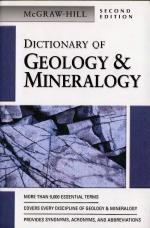Добрый день, Коллеги. Важное сообщение, просьба принять участие. Музей Ферсмана ищет помощь для реставрационных работ в помещении. Подробности по ссылке
Dictionary of geology & mineralogy
The McGraw-Hill Dictionary of Geology and Mineralogy provides a compendium of more than 9000 terms that are central to a broad range of geological sciences and related fields. The coverage in this Second Edition is focused on the areas of geochemistry, geology, geophysics, mineralogy, paleobotany, paleontology, and petrology, with new terms added and others revised as necessary.
Geology deals with the solid earth and the processes that formed and modified it as it evolved Related disciplines include the study of the physics of the earth (geophysics); earth chemistry, composition, and chemical changes (geochemistry); the composition, properties, and structure of minerals (mineralogy); the description, classification, origin, and evolution of rocks (petrology); and the study of ancient life (paleontology).
All of the definitions are drawn from the McGraw-Hill Dictionary of Scientific and technical Terms, Sixth Edition (2003). Each definition is classified according to the field with which it is primarily associated; if it is used in more than one area; it is identified by the general label |geology|. The pronunciation of each term is provided along with synonyms, acronyms, and abbreviations where appropriate. A guide to the use of the Dictionary appears on pages vii-viii, explaining the alphabetical organization of terms, the format of the book, cross referencing, and how synonyms, variant spellings, abbreviations, mineral formulas, and similar information are handled. The Pronunciation Key is provided on page x. The Appendix provides conversion tables for commonly used scientific units as well as revised geologic time scale, periodic table, historical information, and useful listings of geological and mineralogical data.
It is the editors' hope that the Second Edition of the McGraw-Hill Dictionary of Geology and Mineralogy will serve the needs of scientists, engineers, students, teachers, librarians, and writers for high-quality information, and that it will contribute to scientific literacy and communication.




